SELF CLEANING TANKS | LARVAL / ROTIFER
HUBBS SEA WORLD RESEARCH INSTITUTE
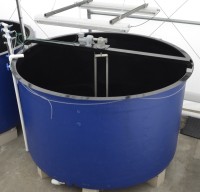
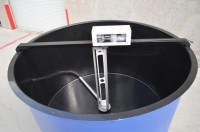

Hubbs Sea World Research Institute (HSWRI), located in San Diego, CA cultures a variety of species for both research and replenishment. When developing a product line such as our self cleaning tanks, it is imperative the design is validated and field tested as we don't have larvae or fish at our manufacturing plant. Through a collaborative grant with HSWRI, CSU, and Sea Grant, we manufactured 6 identical tanks, 3 with cleaning arms and 3 without to run in triplicate studies. After 4 iterations, each one focusing on small details of performance, the Self Cleaning Tank was born. Each arm was tested with high densities of seriola sp. (Yellowtail) and Sciaenidae sp. (White seabass) to mimic commercial scale larval culture conditions. Since then we have continued to make adjustments in performance and material utilization to improve the product line. Developed as 316 stainless steel throughout, we found for marine applications even 316 stainless steel was not good enough to resist the vigor's of full strength sea water. Now for marine applications we have developed a cleaning arm assembly made from fiberglass, PVC plastic, and titanium to offer the most corrosion resistant product in our portfolio.
EARTH OCEAN FARMS
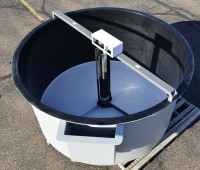
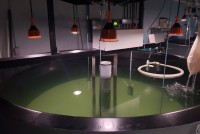
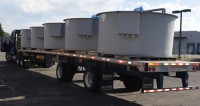
Earth Ocean Farms (EOF) located in La Paz, Mexico cultures both Totoaba and Red Snapper. Interested in our self cleaning tank technology EOF purchased six 2.4m 3 self cleaning larval tanks for evaluation while in the midst of planning for their massive commercial expansion. After seeing the improvement in water quality and the great reduction in labor the self cleaning tanks offered, they placed an order for fifteen 7.5m 3 to be installed in their new commercial aquaculture facility. Through their experiences with the larval system and the feedback they gave us as "real world users", we developed an arm assembly made from fiberglass, PVC plastic, and titanium to reduce surface rust they we're incurring on the arms due to warm saline waters in La Paz. We always appreciate and encourage feedback from clients so we can continue to improve innovate in our industry.
KAMPACHI FARMS
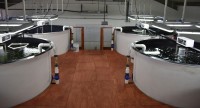
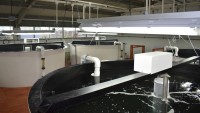
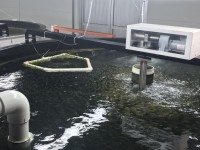
Kampachi Farms in La Paz, Mexico commercially cultures seriola Riviolana (Yellowtail). Anyone remotely familiar with seriola sp. knows this finfish has a very high metabolism consuming oxygen and producing waste at alarming rates. Siphoning a commercial scale larval tank can take a technician over 45 minutes and in the process many viable larvae will be siphoned in the process. Our self cleaning tanks utilize an arm to sweep the solid waste into a single trough extending from the center of the tank to the side wall. The solid waste is siphoned from this trough in seconds. The side wall squeegee minimizes biofilm growing on the walls and greatly reduces BOD by getting the solids out of the tanks rapidly. The tank has freed up a great deal time where the technicians at Kampachi Farms would be siphoning tanks and allows them to focus on other key components of the culture process. Our 7.5m 3 regularly produces over 100,000 viable 5 gram yellowtail juveniles between 45-55% survival at Kampachi Farms. Not only a testament to the tank performance, but the management and technicians who spend long hours at Kampachi Farms to assure their success. The tank will not do it alone.
IOWA DEPT. OF NATURAL RESOURCES
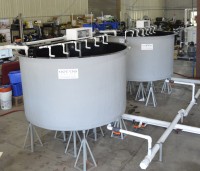
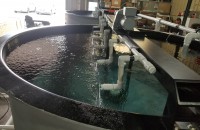
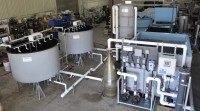
Iowa Department of Natural Resources has been a key player in the development of Walleye aquaculture for years. Oceans Design designed and manufactured a recirculating aquaculture system with two 2.4m 3 self cleaning larval tanks. The system was challenging as everything had to sit on a concrete floor with limited ceiling height. Walleye larvae/juveniles are voracious eaters and to complicate things, during the larval stages clay is utilized to provide turbidity to the water. Each larval tank was outfitted with surface sprayers to break the surface tension of the water/air interface to promote swim bladder inflation. This system was designed, manufactured, and water tested as a complete unit in our manufacturing plant in Colorado Springs, CO.
ED WEED FISH CULTURE STATION
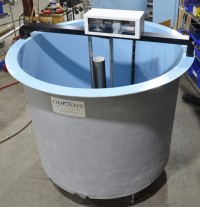
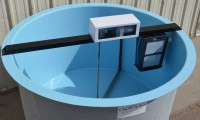
The Ed Weed Fish Culture Station in Grand Isle, Vermont cultures walleye to support one of Vermont's most valuable natural resources. Due to the unique behavior of Walleye the dimensions they desired was not a size we would have considered. Through our sister company Gemini Fiberglass we built a mold for the tank which has features critical to all our self cleaning tanks. The bottom has to be completely flat, tank built as close to a perfect circle as possible, and built with layers of fiberglass materials that will keep the tank in the same shape as it was when pulled off the mold. Ed Weed Fish Culture Station had such great success with the tanks they ordered 4 more a year later. The reduction in labor input and the improved water quality during and after weaning make these tanks pay for themselves in short period of time. With a estimated 400% reduction in labor associated with cleaning/siphoning of typical larval tanks, it has become a wise investment for Ed Weed Fish Culture Station and many others.
FLORIDA FISH AND WILDLIFE
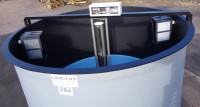
Oceans Design fabricated six 5.7m 3 self cleaning tanks for Florida Fish and Wildlife Conservation which we're a hybrid between the two configurations we offer. Our self cleaning tanks can be ordered as center draining or side draining. Our center drain tanks have a central screen in which the cleaning arm rotates around. An air ring at the base of the screen keeps debris and larvae away from the screen promoting settling of the solids where the arm can sweep them into the collection trough. Our side wall models utilize our EZ Slide screen boxes which hang off the inner side wall. Swapping an individual screen takes a matter of seconds and is easily washed with a hose. The combination of the two turned out to be a great success for Florida Fish and Wildlife Conservation. They have been amazed at how clean their tanks are throughout a larval run.
AQUINOR CHILE
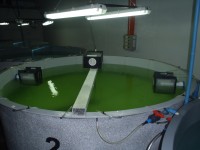
Oceans Design was contracted to design and manufacture a unique 6 cubic meter self cleaning tank based upon our original motorized cleaning arm utilizing a center bottom inlet to introduce both algae and live feed with the influent water supply. The tanks were upwelling and used our EZ Slide Screens for effluent discharge. The tanks were used to culture Seriola lalandi (Yellowtail kingfish) from egg to juvenile.
This is the first known commercial use of a self cleaning arm with a center bottom inlet and written about in Aquaculture Magazine. Article The design and implementation of the self cleaning larval tank was a result of a collaboration between Oceans Design and one of our available consultants Dr Sagiv Kolkovski, out of Western Australia.
|
|